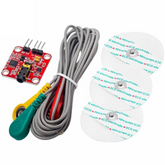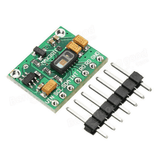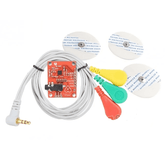Beginner Guide to Biomedical Sensors
Summary
Are you looking to understand the technology behind biomedical sensors? then check out our blog which delves into the subject, covering everything from the definition of biomedical sensor systems to their types and how they work.
The blog also outlines the key differences between biosensors and biomedical sensors, while exploring the components that make up a typical biomedical sensor.
Whether you're a student, a healthcare professional, or just someone interested in the latest technological advances in healthcare, this blog is sure to be an informative read.
Biomedical sensors measure different physiological parameters in the human body, and they are integral to healthcare and medical research.
These devices enable non-invasive monitoring of vital signs and other essential information. In this article, we'll delve into the diverse range of biomedical sensors, their operational principles, and their applications.
What is a biomedical sensor system?
A biomedical sensor system is a device that consists of a sensor and a transducer. The sensor is the part of the device that comes into contact with the body and detects the physiological parameter of interest.
The transducer is responsible for transforming the physiological signal into an electrical signal, which can be interpreted and evaluated by an electronic device.
Visit our Sensor Kits collection page for hands on learning.
What are biomedical sensors made of?
A range of materials, such as metals, ceramics, and polymers, can be utilized for producing biomedical sensors. The choice of material depends on the application and the specific physiological parameter being measured.
To illustrate, glucose level sensors in the blood are usually composed of enzymes and other biological components, whereas heart rate sensors are commonly made of metal or ceramic materials.
Difference between Biosensor & Biomedical sensor
A biosensor is a sensor that utilizes biological components, such as enzymes or antibodies, to identify specific molecules or compounds.
In contrast, biomedical sensors measure different physiological parameters in the human body. Although biosensors are a subset of biomedical sensors, the two terms are frequently used interchangeably
Types of Biomedical sensors
There are many different types of biomedical sensors, each designed to measure a specific physiological parameter. Some of the most common types of biomedical sensors include:
Heart rate sensors:
Heart rate sensors measure the electrical activity of the heart, allowing for the monitoring of heart rate and other cardiac parameters.
Oxygen sensors:
Oxygen sensors measure the oxygen saturation of the blood, allowing for the monitoring of oxygen levels in the body.
Blood glucose sensors:
These sensors measure the glucose levels in the blood, allowing for the monitoring of blood sugar levels in patients with diabetes.
Temperature sensors:
Temperature sensors measure the body temperature, allowing for the monitoring of fever and other conditions.
Electroencephalography (EEG) sensors:
These sensors measure the electrical activity of the brain, allowing for the monitoring of brain function and the diagnosis of neurological disorders.
Electromyography (EMG) sensors:
EMG sensors measure the electrical activity of muscles, allowing for the monitoring of muscle activity and the diagnosis of muscle disorders.
Blood pressure sensors:
These sensors measure the pressure of the blood flow in the body, allowing for the monitoring of blood pressure.

How does it work?
The working principle of a biomedical sensor depends on the specific type of sensor and the physiological parameter being measured. Nonetheless, in general, biomedical sensors operate by converting a physiological signal into an electrical signal that can be interpreted and scrutinized by an electronic apparatus.
- Transduction: The first step in the working of a biomedical sensor is the transduction process, where the physiological signal is converted into an electrical signal. This conversion is typically done using a transducer, which can be an electrical, optical, or chemical device.
- Detection: The electrical signal generated by the transducer is then amplified and processed by the sensor's electronic circuit, which detects the desired physiological parameter.
- Signal processing: The sensor's electronic circuit then processes the detected signal and converts it into a digital signal that can be read by an electronic device.
- Output: The sensor then sends the processed digital signal to an electronic device, such as a computer or a mobile device, for analysis and display.

It's worth noting that the specific working principle may vary depending on the type of sensor and the physiological parameter being measured, for example, a glucose sensor works by measuring the electrical current generated by the interaction between glucose and enzymes in the sensor, while a temperature sensor may use a thermistor that changes its resistance based on the temperature.
Examples
- A wearable fitness tracker that includes a heart rate sensor, an accelerometer, and an oxygen sensor to monitor heart rate, physical activity, and oxygen levels.
- A glucose monitoring system that includes a glucose sensor and a portable device that tracks glucose levels in real time.
- A temperature sensor in a smart thermometer that allows for non-invasive monitoring of body temperature.
Applications
Biomedical sensors have a wide range of applications in healthcare and medical research. Some of the most common applications include:
- Patient monitoring: Biomedical sensors are widely used in hospitals and other healthcare facilities for the non-invasive monitoring of vital signs and other important information.
- Clinical research: Biomedical sensors are used in clinical research studies to collect data on physiological parameters and monitor the effectiveness of treatments.
- Wearable devices: Biomedical sensors are integrated into a wide range of wearable devices, including fitness trackers and smartwatches, to allow for continuous monitoring of physiological parameters.
- Telemedicine: Biomedical sensors can be used in telemedicine applications to remotely monitor patients and to collect data on physiological parameters.
- Medical imaging: Biomedical sensors are used in medical imaging techniques, such as magnetic resonance imaging (MRI) and computed tomography (CT) scans, to improve image quality and collect additional information.
- Rehabilitation: Biomedical sensors are used in rehabilitation applications to monitor the progress of patients and to collect data on physiological parameters.
- Home healthcare: Biomedical sensors can be used in home healthcare applications to monitor patients and collect data on physiological parameters, allowing for remote monitoring and care.
Conclusion
Biomedical sensors play a crucial role in the field of healthcare and medical research. With the continued development of new technologies, biomedical sensors are becoming increasingly sophisticated, allowing for non-invasive monitoring of a wide range of physiological parameters.
If you appreciate our work don't forget to share this post and leave your opinion in the comment box.
Please do check out other blog posts about Popular Electronics
Make sure you check out our wide range of products and collections (we offer some exciting deals!)










